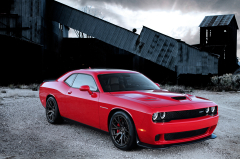PORTLAND, Ore., – We came out of Turn 9 into a long arc that seemed more like a straight-away at the Portland International Raceway and hit 105 mph before braking to enter Turn 10. We were driving the 2015 Dodge Challenger SRT Hellcat; well we were actually riding with a professional driver to get a feel for what this Dodge Challenger SRT could do in expert hands.
One thing was clear, this 1.9 mile, 12 turn asphalt and concrete road racing track really wasn’t configured for the likes of the 2015 Dodge Challenger SRT Hellcat. That is the official name for this muscle car but look for it to be condensed to Hellcat which is a perfect fit for its personality. The car will go on sale toward the end of 2014.
The Dodge Challenger SRT Hellcat had a 6.2-liter supercharged V8 that made 707 horsepower and 650 pound-feet of torque. It could be mated to a six-speed manual transmission or a bulked up eight-speed automatic gear-box capable of funneling the massive torque that the engine made to the rear wheels and onto the pavement.
At the track, we had the eight-speed automatic. The gear box didn’t matter though; the performance of this car rivaled that of some supercars which cost 10 to 20 times more than its $60,990 base price. Some numbers have not been finalized like the SRT Hellcat’s zero to 60 mph time but that is expected to be in the low three seconds.
Top speed is 199 mph, the supercharger can pump 30,000 liters of air into the engine in one minute and wide open that engine will gulp 1.5 gallons of gasoline every 60 seconds, draining the 19.1 gallon fuel tank in 13 minutes. But driven normally, it has been reported that the Hellcat could get 20 mpg on the highway though official EPA numbers had not been released at the time of the test drive.
The Hellcat engine is not simply a bump up of the last Challenger SRT powerplant, 91 percent of its parts are new. A deep-skirt cast-iron block with cross-bolted main bearing caps, unique aluminum alloy heads with hemispherical combustion chambers and a screw-type IHI supercharger are at its core.
Dodge has managed to corral the Challenger Hellcat’s power when needed. First the car will come with a pair of key FOBs, one red the other black. The red one releases all of the car’s oomph but the black one will hold output to 500 horsepower.
Then there will be valet mode that holds rpms to 4,000, limiting horsepower and torque output, it locks out first gear and it prohibits upshifts earlier than normal. What’s more, traction, steering and suspension controls are set to their street settings; paddle shifters, drive modes and launch control are disabled and ESC is enabled to full-on. It takes a four digit code to activate valet mode as well turn it off.
This safeguards your Hellcat from free-spirted valets or from anybody else taking it for an unauthorized full-power joy ride.
Implicit in locking out those controls is that the Hellcat has them in first place. Owners will be able to choose transmission shift speeds, steering ratios, paddle shifters’ shift rates on the automatic gearbox, traction control and the suspension settings. The pre-configured drive-modes are sport, track and default settings. There is also a mode that lets the driver customize the settings.
While screeching around Portland’s raceway, our Hellcat was in track mode. The readouts told us how much torque and horsepower were being used in real time, the g-forces the car was generating, and of course oil temperature, oil pressure and voltage output. That was just some of the data; there were multiple screens of information including a zero to 60 mph timer.
For this Challenger, designers benchmarked and updated styling of the 1971 Dodge Challenger. The car had a new vertical split grille, a power bulge aluminum hood with cold air intake. The hood on the Hellcat had dual air extractors; it also had an inlet port that fed air into the engine air box.
Quad headlamps were more detailed than on the last Charger. And the car had a larger front splitter designed for optimal downforce to minimize lift. At the rear, tail lamps featured Dodge’s new LED graphic with its continuous glow of light. The Hellcat had a redesigned rear valance that gave it a more planted on the ground look and it had a taller rear spoiler with a raised SRT logo.
Inside, the Hellcat instrument panel had a stamped aluminum bezel, a configurable driver information display screen, and the analogue speedometer and tachometer were finished in dark red. There was an 8.4-inch UConnect screen. The eight-speed transmission had a T-lever shifter while the manual gearbox featured a ball shifter.
The individualized sport seats could be heated and cooled, a heated steering wheel would warm the entire wheel and Mopar, the automaker’s in-house customized parts operation, has developed 100 accessories for the 2015 Dodge Challenger in all its iterations.
About the only quibble we had was that it was near impossible to see out the rearward angle that takes the eye to the opposite C-pillar from the driver’s while backing up. But we see no problem in learning to adapt and live with that idiosyncrasy.
The 2015 Dodge Challenger SRT Hellcat has raised the bar for American made Muscle Cars by a bunch.
Frank S. Washington is editor of AboutThatCar.com.




